Analysis of Low Impact Manufacturing in the Food Industry Report
VerifiedAdded on 2021/01/02
|9
|2435
|247
Report
AI Summary
This report analyzes low-impact manufacturing processes within the context of food production, specifically focusing on biscuit manufacturing at United Biscuits. It identifies and quantifies the five most significant energy-using processes: production, mixing, baking, and cooling, detailing methods for quantifying energy consumption at each stage. The report then illustrates energy flows using a Sankey diagram, highlighting energy conversions and losses within the facility. Furthermore, it explores the suitability of renewable energy sources like solar and biomass for the food industry, emphasizing their potential to reduce operational costs and environmental impact. The report concludes that by optimizing energy usage and integrating renewable energy sources, United Biscuits can achieve significant cost savings and improve sustainability in its manufacturing processes.
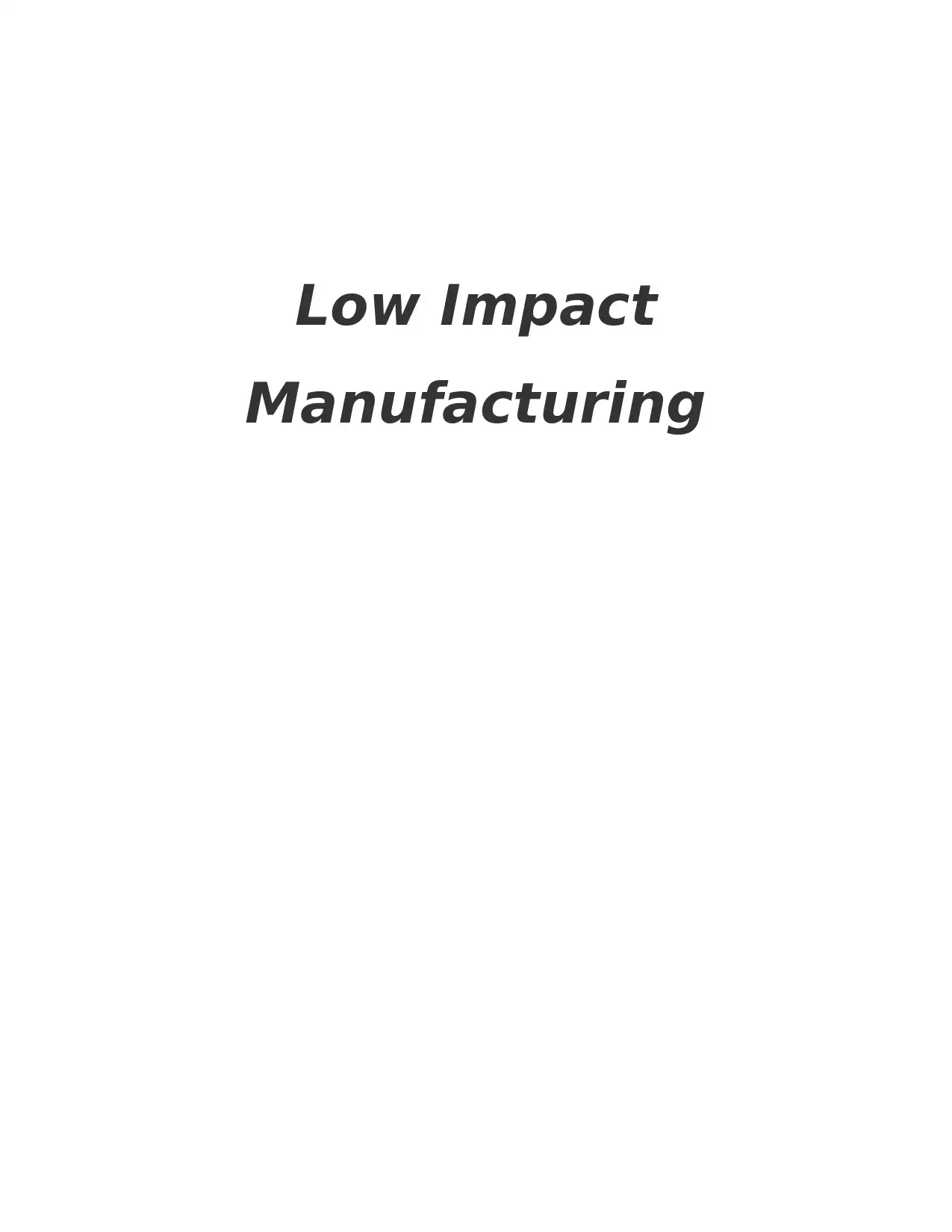
Low Impact
Manufacturing
Manufacturing
Paraphrase This Document
Need a fresh take? Get an instant paraphrase of this document with our AI Paraphraser
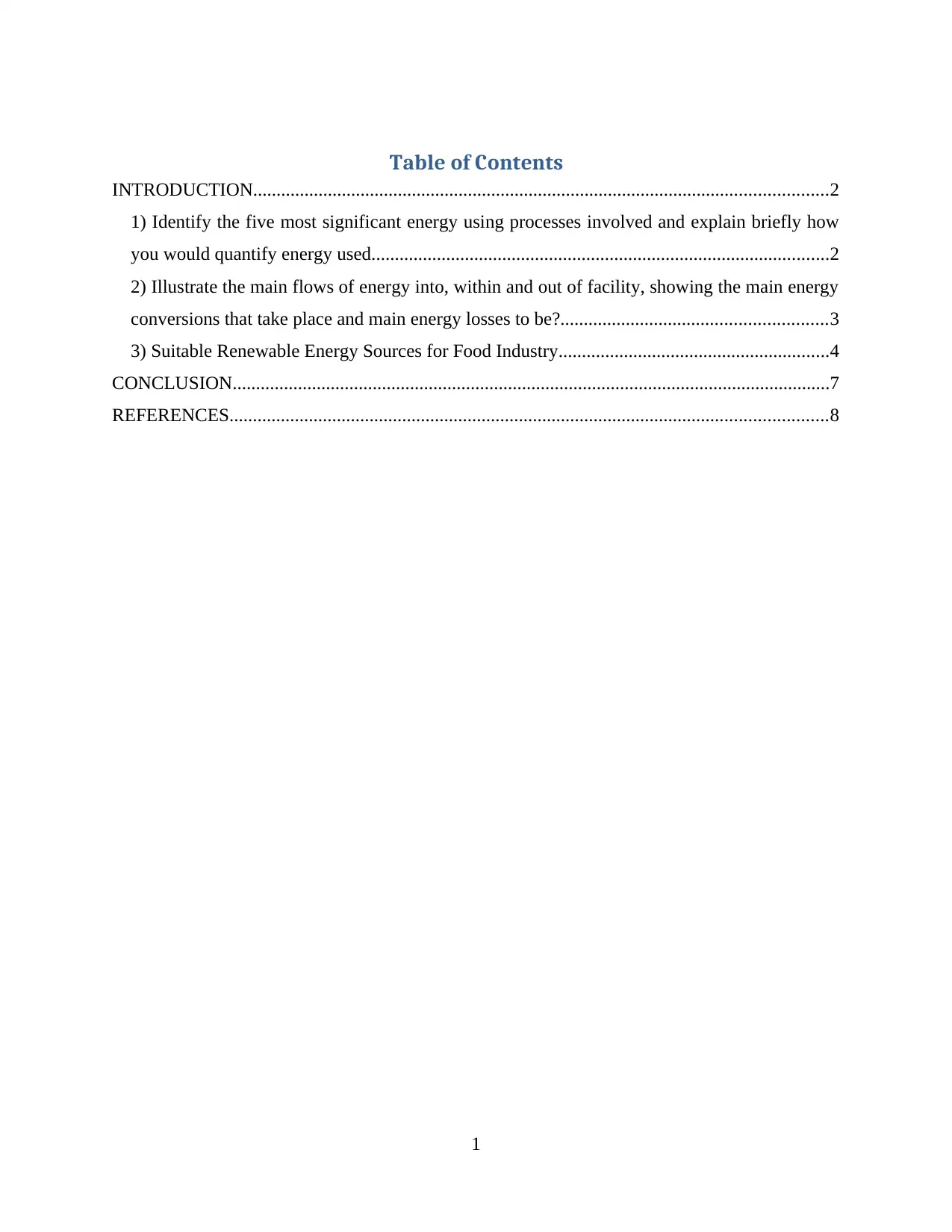
Table of Contents
INTRODUCTION...........................................................................................................................2
1) Identify the five most significant energy using processes involved and explain briefly how
you would quantify energy used..................................................................................................2
2) Illustrate the main flows of energy into, within and out of facility, showing the main energy
conversions that take place and main energy losses to be?.........................................................3
3) Suitable Renewable Energy Sources for Food Industry..........................................................4
CONCLUSION................................................................................................................................7
REFERENCES................................................................................................................................8
1
INTRODUCTION...........................................................................................................................2
1) Identify the five most significant energy using processes involved and explain briefly how
you would quantify energy used..................................................................................................2
2) Illustrate the main flows of energy into, within and out of facility, showing the main energy
conversions that take place and main energy losses to be?.........................................................3
3) Suitable Renewable Energy Sources for Food Industry..........................................................4
CONCLUSION................................................................................................................................7
REFERENCES................................................................................................................................8
1
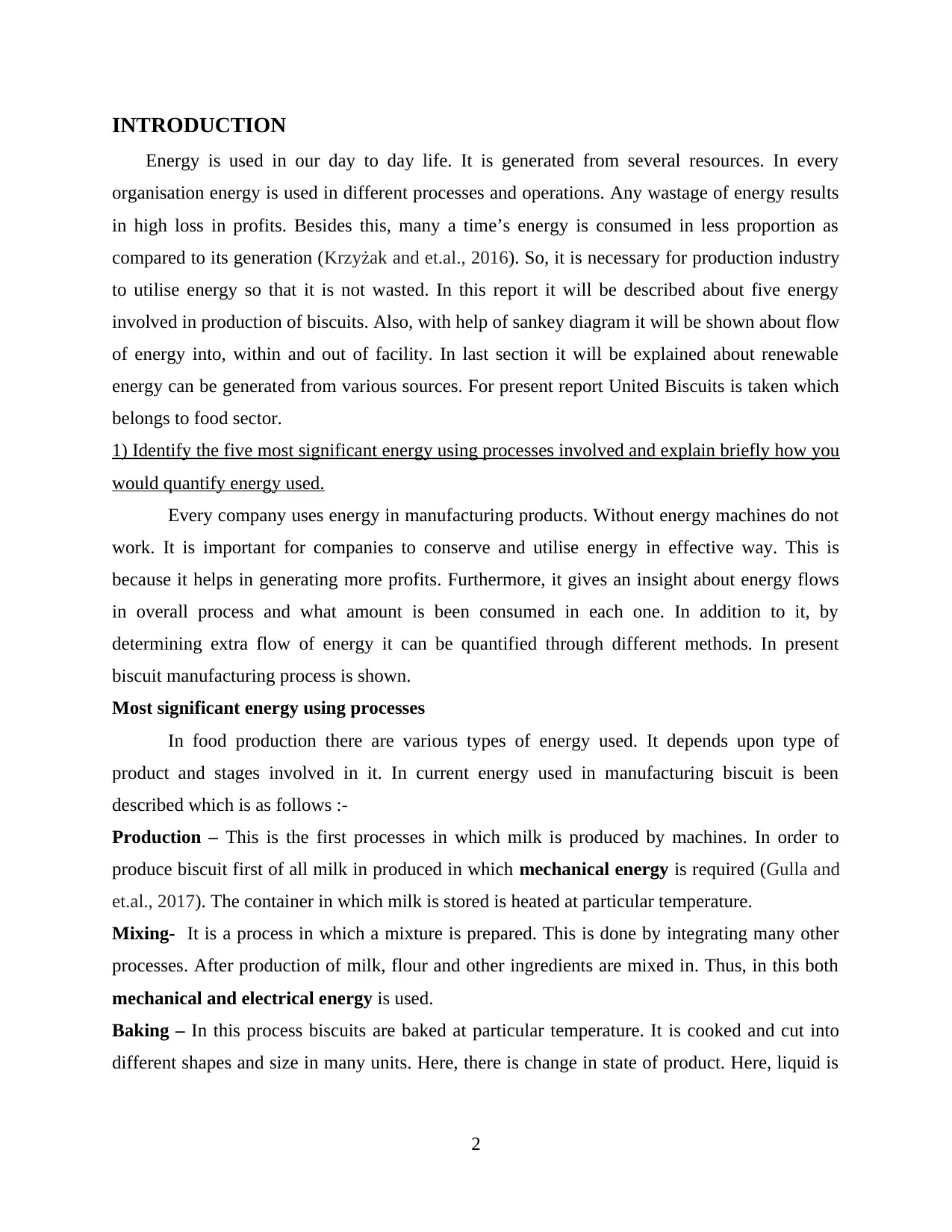
INTRODUCTION
Energy is used in our day to day life. It is generated from several resources. In every
organisation energy is used in different processes and operations. Any wastage of energy results
in high loss in profits. Besides this, many a time’s energy is consumed in less proportion as
compared to its generation (Krzyżak and et.al., 2016). So, it is necessary for production industry
to utilise energy so that it is not wasted. In this report it will be described about five energy
involved in production of biscuits. Also, with help of sankey diagram it will be shown about flow
of energy into, within and out of facility. In last section it will be explained about renewable
energy can be generated from various sources. For present report United Biscuits is taken which
belongs to food sector.
1) Identify the five most significant energy using processes involved and explain briefly how you
would quantify energy used.
Every company uses energy in manufacturing products. Without energy machines do not
work. It is important for companies to conserve and utilise energy in effective way. This is
because it helps in generating more profits. Furthermore, it gives an insight about energy flows
in overall process and what amount is been consumed in each one. In addition to it, by
determining extra flow of energy it can be quantified through different methods. In present
biscuit manufacturing process is shown.
Most significant energy using processes
In food production there are various types of energy used. It depends upon type of
product and stages involved in it. In current energy used in manufacturing biscuit is been
described which is as follows :-
Production – This is the first processes in which milk is produced by machines. In order to
produce biscuit first of all milk in produced in which mechanical energy is required (Gulla and
et.al., 2017). The container in which milk is stored is heated at particular temperature.
Mixing- It is a process in which a mixture is prepared. This is done by integrating many other
processes. After production of milk, flour and other ingredients are mixed in. Thus, in this both
mechanical and electrical energy is used.
Baking – In this process biscuits are baked at particular temperature. It is cooked and cut into
different shapes and size in many units. Here, there is change in state of product. Here, liquid is
2
Energy is used in our day to day life. It is generated from several resources. In every
organisation energy is used in different processes and operations. Any wastage of energy results
in high loss in profits. Besides this, many a time’s energy is consumed in less proportion as
compared to its generation (Krzyżak and et.al., 2016). So, it is necessary for production industry
to utilise energy so that it is not wasted. In this report it will be described about five energy
involved in production of biscuits. Also, with help of sankey diagram it will be shown about flow
of energy into, within and out of facility. In last section it will be explained about renewable
energy can be generated from various sources. For present report United Biscuits is taken which
belongs to food sector.
1) Identify the five most significant energy using processes involved and explain briefly how you
would quantify energy used.
Every company uses energy in manufacturing products. Without energy machines do not
work. It is important for companies to conserve and utilise energy in effective way. This is
because it helps in generating more profits. Furthermore, it gives an insight about energy flows
in overall process and what amount is been consumed in each one. In addition to it, by
determining extra flow of energy it can be quantified through different methods. In present
biscuit manufacturing process is shown.
Most significant energy using processes
In food production there are various types of energy used. It depends upon type of
product and stages involved in it. In current energy used in manufacturing biscuit is been
described which is as follows :-
Production – This is the first processes in which milk is produced by machines. In order to
produce biscuit first of all milk in produced in which mechanical energy is required (Gulla and
et.al., 2017). The container in which milk is stored is heated at particular temperature.
Mixing- It is a process in which a mixture is prepared. This is done by integrating many other
processes. After production of milk, flour and other ingredients are mixed in. Thus, in this both
mechanical and electrical energy is used.
Baking – In this process biscuits are baked at particular temperature. It is cooked and cut into
different shapes and size in many units. Here, there is change in state of product. Here, liquid is
2
⊘ This is a preview!⊘
Do you want full access?
Subscribe today to unlock all pages.

Trusted by 1+ million students worldwide
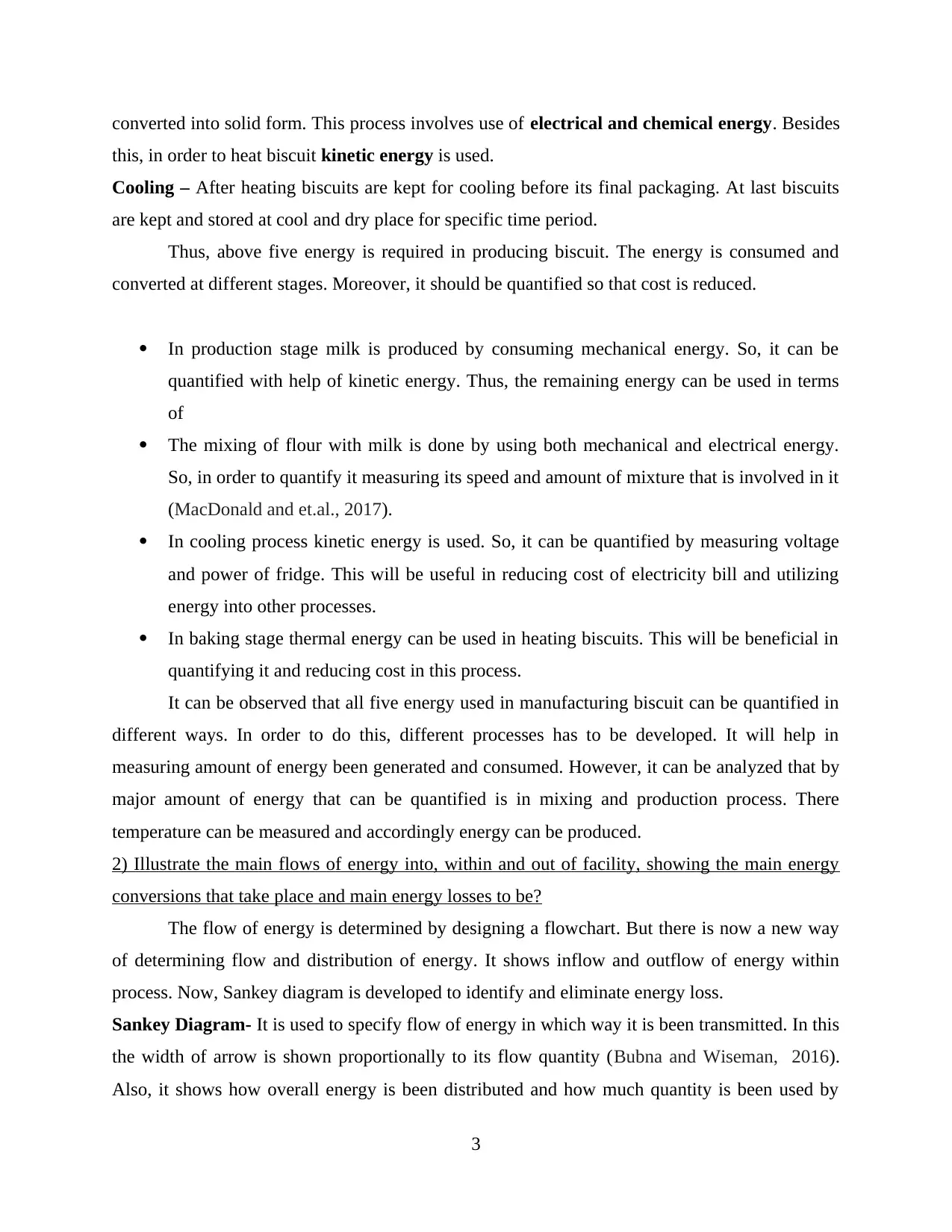
converted into solid form. This process involves use of electrical and chemical energy. Besides
this, in order to heat biscuit kinetic energy is used.
Cooling – After heating biscuits are kept for cooling before its final packaging. At last biscuits
are kept and stored at cool and dry place for specific time period.
Thus, above five energy is required in producing biscuit. The energy is consumed and
converted at different stages. Moreover, it should be quantified so that cost is reduced.
In production stage milk is produced by consuming mechanical energy. So, it can be
quantified with help of kinetic energy. Thus, the remaining energy can be used in terms
of
The mixing of flour with milk is done by using both mechanical and electrical energy.
So, in order to quantify it measuring its speed and amount of mixture that is involved in it
(MacDonald and et.al., 2017).
In cooling process kinetic energy is used. So, it can be quantified by measuring voltage
and power of fridge. This will be useful in reducing cost of electricity bill and utilizing
energy into other processes.
In baking stage thermal energy can be used in heating biscuits. This will be beneficial in
quantifying it and reducing cost in this process.
It can be observed that all five energy used in manufacturing biscuit can be quantified in
different ways. In order to do this, different processes has to be developed. It will help in
measuring amount of energy been generated and consumed. However, it can be analyzed that by
major amount of energy that can be quantified is in mixing and production process. There
temperature can be measured and accordingly energy can be produced.
2) Illustrate the main flows of energy into, within and out of facility, showing the main energy
conversions that take place and main energy losses to be?
The flow of energy is determined by designing a flowchart. But there is now a new way
of determining flow and distribution of energy. It shows inflow and outflow of energy within
process. Now, Sankey diagram is developed to identify and eliminate energy loss.
Sankey Diagram- It is used to specify flow of energy in which way it is been transmitted. In this
the width of arrow is shown proportionally to its flow quantity (Bubna and Wiseman, 2016).
Also, it shows how overall energy is been distributed and how much quantity is been used by
3
this, in order to heat biscuit kinetic energy is used.
Cooling – After heating biscuits are kept for cooling before its final packaging. At last biscuits
are kept and stored at cool and dry place for specific time period.
Thus, above five energy is required in producing biscuit. The energy is consumed and
converted at different stages. Moreover, it should be quantified so that cost is reduced.
In production stage milk is produced by consuming mechanical energy. So, it can be
quantified with help of kinetic energy. Thus, the remaining energy can be used in terms
of
The mixing of flour with milk is done by using both mechanical and electrical energy.
So, in order to quantify it measuring its speed and amount of mixture that is involved in it
(MacDonald and et.al., 2017).
In cooling process kinetic energy is used. So, it can be quantified by measuring voltage
and power of fridge. This will be useful in reducing cost of electricity bill and utilizing
energy into other processes.
In baking stage thermal energy can be used in heating biscuits. This will be beneficial in
quantifying it and reducing cost in this process.
It can be observed that all five energy used in manufacturing biscuit can be quantified in
different ways. In order to do this, different processes has to be developed. It will help in
measuring amount of energy been generated and consumed. However, it can be analyzed that by
major amount of energy that can be quantified is in mixing and production process. There
temperature can be measured and accordingly energy can be produced.
2) Illustrate the main flows of energy into, within and out of facility, showing the main energy
conversions that take place and main energy losses to be?
The flow of energy is determined by designing a flowchart. But there is now a new way
of determining flow and distribution of energy. It shows inflow and outflow of energy within
process. Now, Sankey diagram is developed to identify and eliminate energy loss.
Sankey Diagram- It is used to specify flow of energy in which way it is been transmitted. In this
the width of arrow is shown proportionally to its flow quantity (Bubna and Wiseman, 2016).
Also, it shows how overall energy is been distributed and how much quantity is been used by
3
Paraphrase This Document
Need a fresh take? Get an instant paraphrase of this document with our AI Paraphraser
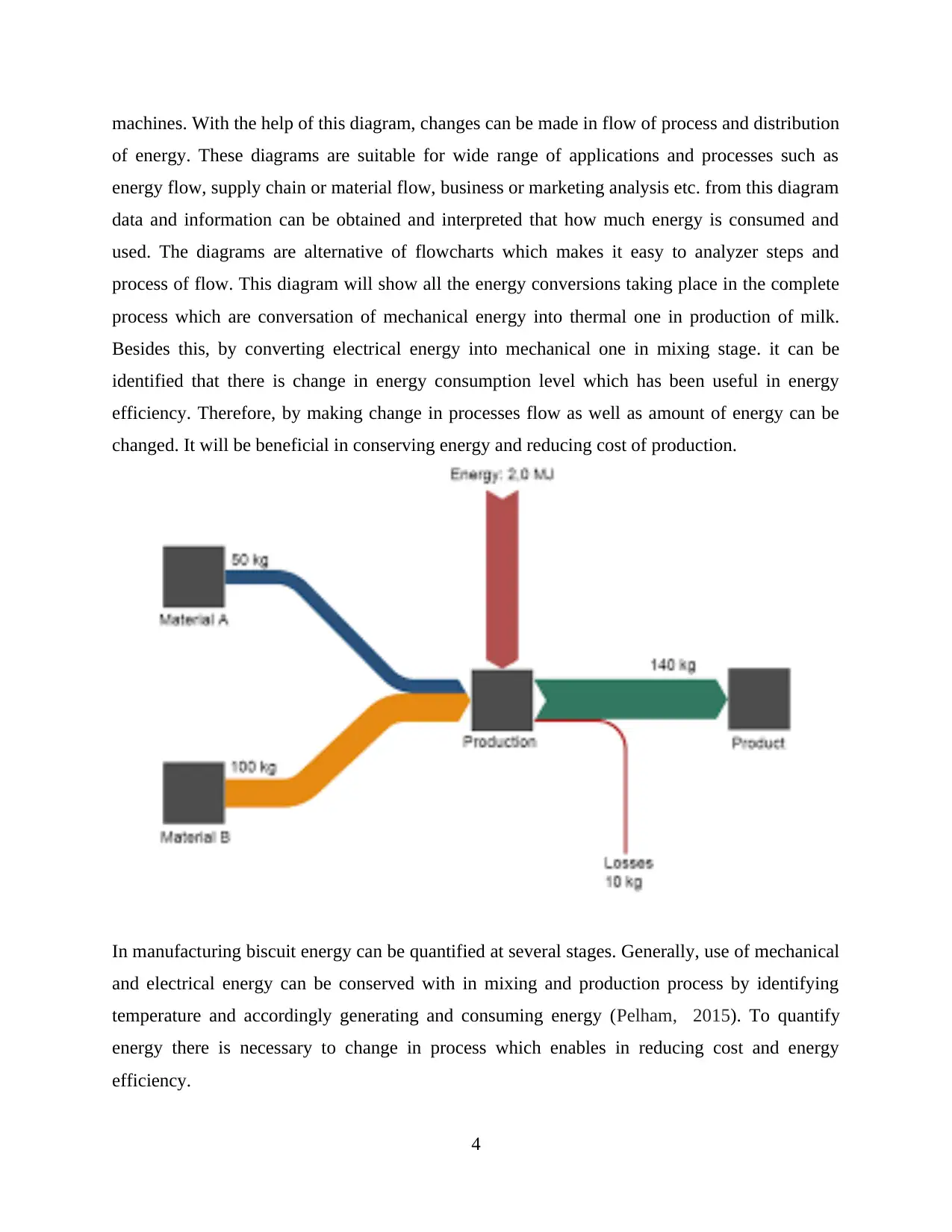
machines. With the help of this diagram, changes can be made in flow of process and distribution
of energy. These diagrams are suitable for wide range of applications and processes such as
energy flow, supply chain or material flow, business or marketing analysis etc. from this diagram
data and information can be obtained and interpreted that how much energy is consumed and
used. The diagrams are alternative of flowcharts which makes it easy to analyzer steps and
process of flow. This diagram will show all the energy conversions taking place in the complete
process which are conversation of mechanical energy into thermal one in production of milk.
Besides this, by converting electrical energy into mechanical one in mixing stage. it can be
identified that there is change in energy consumption level which has been useful in energy
efficiency. Therefore, by making change in processes flow as well as amount of energy can be
changed. It will be beneficial in conserving energy and reducing cost of production.
In manufacturing biscuit energy can be quantified at several stages. Generally, use of mechanical
and electrical energy can be conserved with in mixing and production process by identifying
temperature and accordingly generating and consuming energy (Pelham, 2015). To quantify
energy there is necessary to change in process which enables in reducing cost and energy
efficiency.
4
of energy. These diagrams are suitable for wide range of applications and processes such as
energy flow, supply chain or material flow, business or marketing analysis etc. from this diagram
data and information can be obtained and interpreted that how much energy is consumed and
used. The diagrams are alternative of flowcharts which makes it easy to analyzer steps and
process of flow. This diagram will show all the energy conversions taking place in the complete
process which are conversation of mechanical energy into thermal one in production of milk.
Besides this, by converting electrical energy into mechanical one in mixing stage. it can be
identified that there is change in energy consumption level which has been useful in energy
efficiency. Therefore, by making change in processes flow as well as amount of energy can be
changed. It will be beneficial in conserving energy and reducing cost of production.
In manufacturing biscuit energy can be quantified at several stages. Generally, use of mechanical
and electrical energy can be conserved with in mixing and production process by identifying
temperature and accordingly generating and consuming energy (Pelham, 2015). To quantify
energy there is necessary to change in process which enables in reducing cost and energy
efficiency.
4
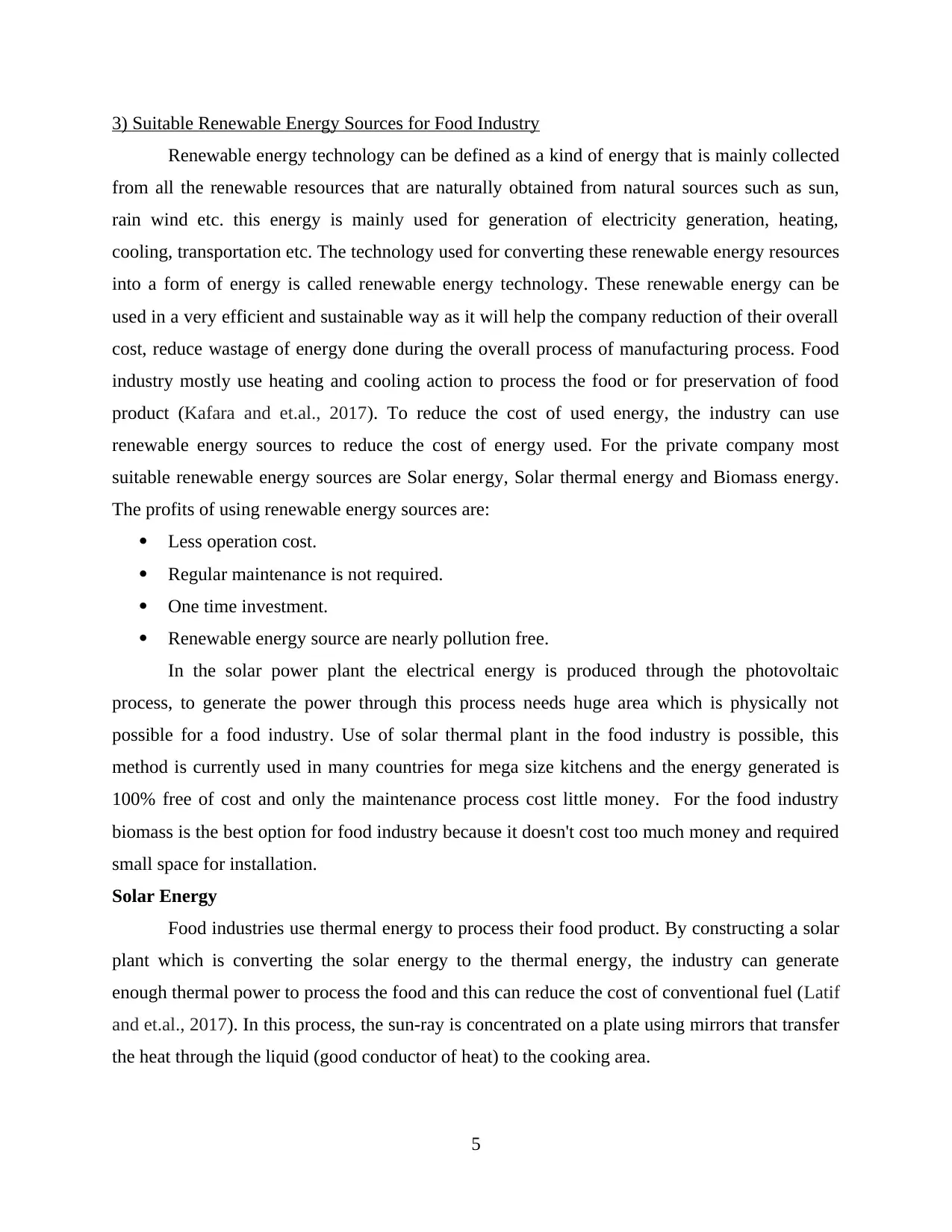
3) Suitable Renewable Energy Sources for Food Industry
Renewable energy technology can be defined as a kind of energy that is mainly collected
from all the renewable resources that are naturally obtained from natural sources such as sun,
rain wind etc. this energy is mainly used for generation of electricity generation, heating,
cooling, transportation etc. The technology used for converting these renewable energy resources
into a form of energy is called renewable energy technology. These renewable energy can be
used in a very efficient and sustainable way as it will help the company reduction of their overall
cost, reduce wastage of energy done during the overall process of manufacturing process. Food
industry mostly use heating and cooling action to process the food or for preservation of food
product (Kafara and et.al., 2017). To reduce the cost of used energy, the industry can use
renewable energy sources to reduce the cost of energy used. For the private company most
suitable renewable energy sources are Solar energy, Solar thermal energy and Biomass energy.
The profits of using renewable energy sources are:
Less operation cost.
Regular maintenance is not required.
One time investment.
Renewable energy source are nearly pollution free.
In the solar power plant the electrical energy is produced through the photovoltaic
process, to generate the power through this process needs huge area which is physically not
possible for a food industry. Use of solar thermal plant in the food industry is possible, this
method is currently used in many countries for mega size kitchens and the energy generated is
100% free of cost and only the maintenance process cost little money. For the food industry
biomass is the best option for food industry because it doesn't cost too much money and required
small space for installation.
Solar Energy
Food industries use thermal energy to process their food product. By constructing a solar
plant which is converting the solar energy to the thermal energy, the industry can generate
enough thermal power to process the food and this can reduce the cost of conventional fuel (Latif
and et.al., 2017). In this process, the sun-ray is concentrated on a plate using mirrors that transfer
the heat through the liquid (good conductor of heat) to the cooking area.
5
Renewable energy technology can be defined as a kind of energy that is mainly collected
from all the renewable resources that are naturally obtained from natural sources such as sun,
rain wind etc. this energy is mainly used for generation of electricity generation, heating,
cooling, transportation etc. The technology used for converting these renewable energy resources
into a form of energy is called renewable energy technology. These renewable energy can be
used in a very efficient and sustainable way as it will help the company reduction of their overall
cost, reduce wastage of energy done during the overall process of manufacturing process. Food
industry mostly use heating and cooling action to process the food or for preservation of food
product (Kafara and et.al., 2017). To reduce the cost of used energy, the industry can use
renewable energy sources to reduce the cost of energy used. For the private company most
suitable renewable energy sources are Solar energy, Solar thermal energy and Biomass energy.
The profits of using renewable energy sources are:
Less operation cost.
Regular maintenance is not required.
One time investment.
Renewable energy source are nearly pollution free.
In the solar power plant the electrical energy is produced through the photovoltaic
process, to generate the power through this process needs huge area which is physically not
possible for a food industry. Use of solar thermal plant in the food industry is possible, this
method is currently used in many countries for mega size kitchens and the energy generated is
100% free of cost and only the maintenance process cost little money. For the food industry
biomass is the best option for food industry because it doesn't cost too much money and required
small space for installation.
Solar Energy
Food industries use thermal energy to process their food product. By constructing a solar
plant which is converting the solar energy to the thermal energy, the industry can generate
enough thermal power to process the food and this can reduce the cost of conventional fuel (Latif
and et.al., 2017). In this process, the sun-ray is concentrated on a plate using mirrors that transfer
the heat through the liquid (good conductor of heat) to the cooking area.
5
⊘ This is a preview!⊘
Do you want full access?
Subscribe today to unlock all pages.

Trusted by 1+ million students worldwide
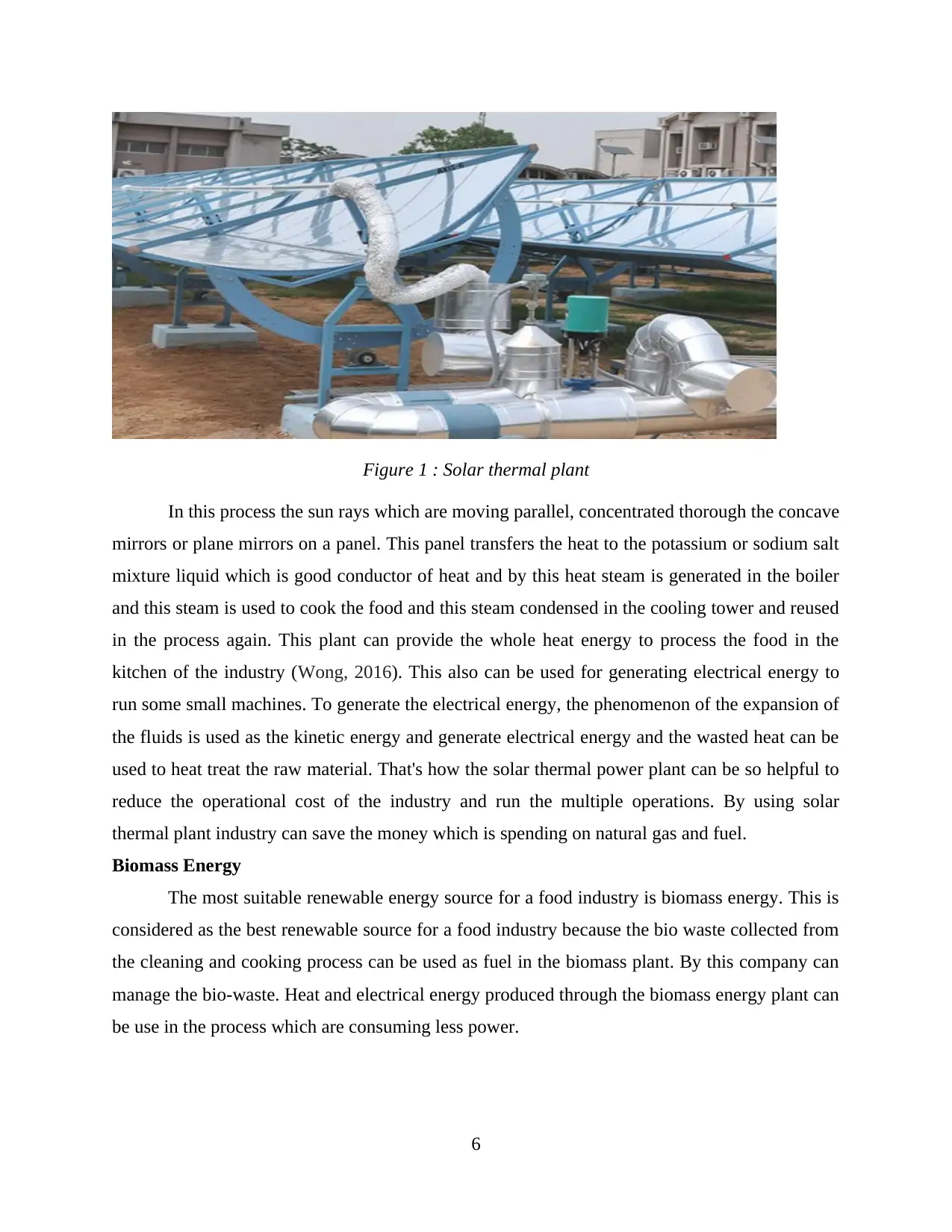
Figure 1 : Solar thermal plant
In this process the sun rays which are moving parallel, concentrated thorough the concave
mirrors or plane mirrors on a panel. This panel transfers the heat to the potassium or sodium salt
mixture liquid which is good conductor of heat and by this heat steam is generated in the boiler
and this steam is used to cook the food and this steam condensed in the cooling tower and reused
in the process again. This plant can provide the whole heat energy to process the food in the
kitchen of the industry (Wong, 2016). This also can be used for generating electrical energy to
run some small machines. To generate the electrical energy, the phenomenon of the expansion of
the fluids is used as the kinetic energy and generate electrical energy and the wasted heat can be
used to heat treat the raw material. That's how the solar thermal power plant can be so helpful to
reduce the operational cost of the industry and run the multiple operations. By using solar
thermal plant industry can save the money which is spending on natural gas and fuel.
Biomass Energy
The most suitable renewable energy source for a food industry is biomass energy. This is
considered as the best renewable source for a food industry because the bio waste collected from
the cleaning and cooking process can be used as fuel in the biomass plant. By this company can
manage the bio-waste. Heat and electrical energy produced through the biomass energy plant can
be use in the process which are consuming less power.
6
In this process the sun rays which are moving parallel, concentrated thorough the concave
mirrors or plane mirrors on a panel. This panel transfers the heat to the potassium or sodium salt
mixture liquid which is good conductor of heat and by this heat steam is generated in the boiler
and this steam is used to cook the food and this steam condensed in the cooling tower and reused
in the process again. This plant can provide the whole heat energy to process the food in the
kitchen of the industry (Wong, 2016). This also can be used for generating electrical energy to
run some small machines. To generate the electrical energy, the phenomenon of the expansion of
the fluids is used as the kinetic energy and generate electrical energy and the wasted heat can be
used to heat treat the raw material. That's how the solar thermal power plant can be so helpful to
reduce the operational cost of the industry and run the multiple operations. By using solar
thermal plant industry can save the money which is spending on natural gas and fuel.
Biomass Energy
The most suitable renewable energy source for a food industry is biomass energy. This is
considered as the best renewable source for a food industry because the bio waste collected from
the cleaning and cooking process can be used as fuel in the biomass plant. By this company can
manage the bio-waste. Heat and electrical energy produced through the biomass energy plant can
be use in the process which are consuming less power.
6
Paraphrase This Document
Need a fresh take? Get an instant paraphrase of this document with our AI Paraphraser
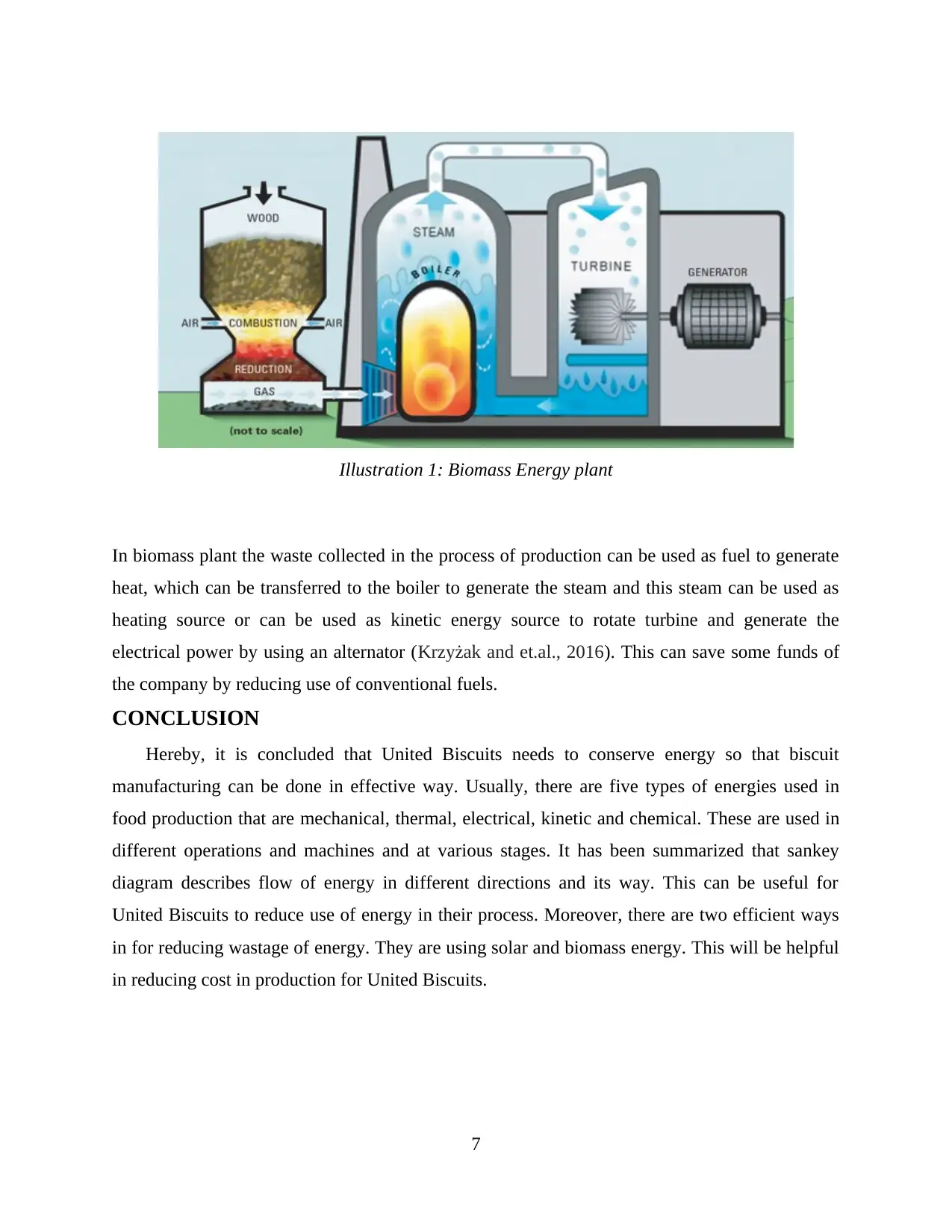
In biomass plant the waste collected in the process of production can be used as fuel to generate
heat, which can be transferred to the boiler to generate the steam and this steam can be used as
heating source or can be used as kinetic energy source to rotate turbine and generate the
electrical power by using an alternator (Krzyżak and et.al., 2016). This can save some funds of
the company by reducing use of conventional fuels.
CONCLUSION
Hereby, it is concluded that United Biscuits needs to conserve energy so that biscuit
manufacturing can be done in effective way. Usually, there are five types of energies used in
food production that are mechanical, thermal, electrical, kinetic and chemical. These are used in
different operations and machines and at various stages. It has been summarized that sankey
diagram describes flow of energy in different directions and its way. This can be useful for
United Biscuits to reduce use of energy in their process. Moreover, there are two efficient ways
in for reducing wastage of energy. They are using solar and biomass energy. This will be helpful
in reducing cost in production for United Biscuits.
7
Illustration 1: Biomass Energy plant
heat, which can be transferred to the boiler to generate the steam and this steam can be used as
heating source or can be used as kinetic energy source to rotate turbine and generate the
electrical power by using an alternator (Krzyżak and et.al., 2016). This can save some funds of
the company by reducing use of conventional fuels.
CONCLUSION
Hereby, it is concluded that United Biscuits needs to conserve energy so that biscuit
manufacturing can be done in effective way. Usually, there are five types of energies used in
food production that are mechanical, thermal, electrical, kinetic and chemical. These are used in
different operations and machines and at various stages. It has been summarized that sankey
diagram describes flow of energy in different directions and its way. This can be useful for
United Biscuits to reduce use of energy in their process. Moreover, there are two efficient ways
in for reducing wastage of energy. They are using solar and biomass energy. This will be helpful
in reducing cost in production for United Biscuits.
7
Illustration 1: Biomass Energy plant
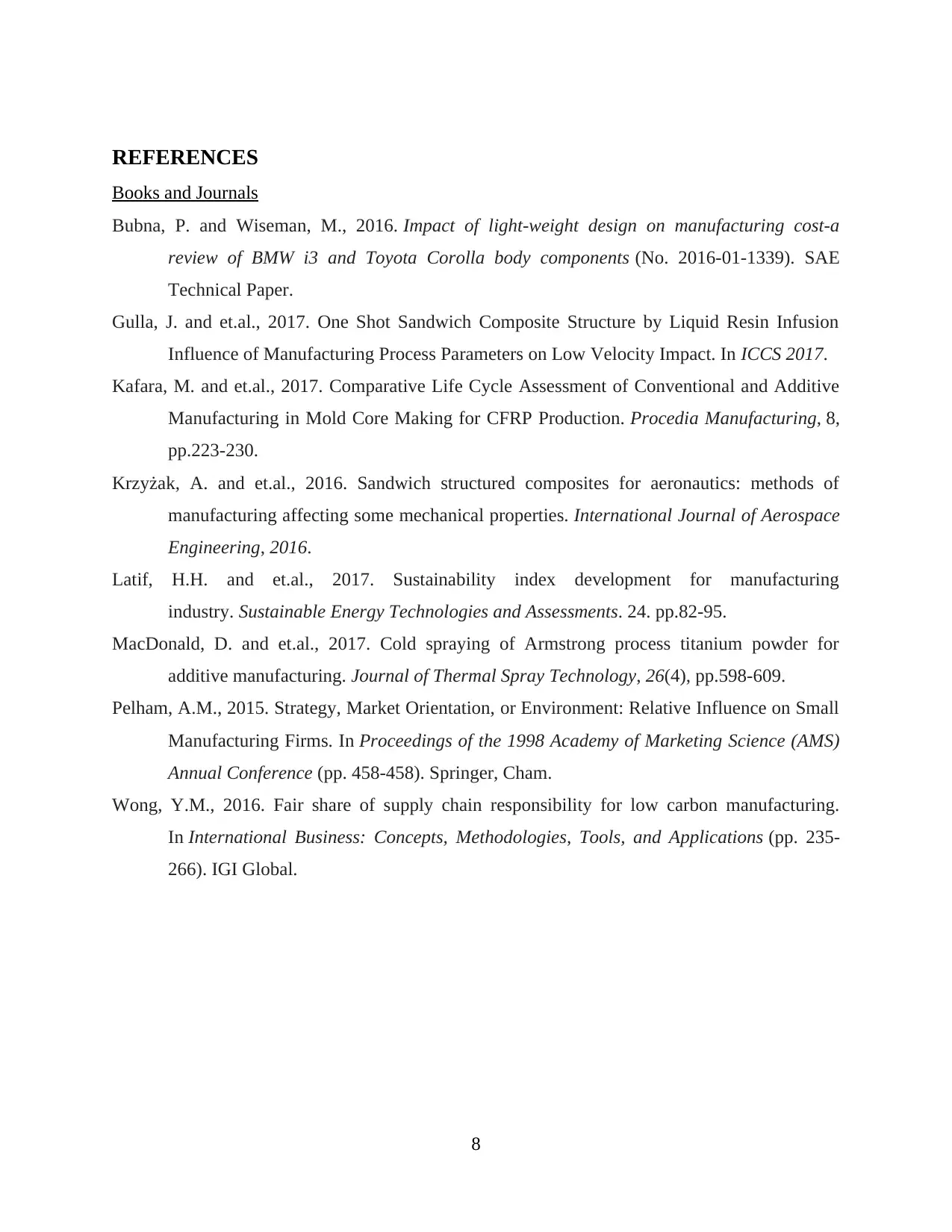
REFERENCES
Books and Journals
Bubna, P. and Wiseman, M., 2016. Impact of light-weight design on manufacturing cost-a
review of BMW i3 and Toyota Corolla body components (No. 2016-01-1339). SAE
Technical Paper.
Gulla, J. and et.al., 2017. One Shot Sandwich Composite Structure by Liquid Resin Infusion
Influence of Manufacturing Process Parameters on Low Velocity Impact. In ICCS 2017.
Kafara, M. and et.al., 2017. Comparative Life Cycle Assessment of Conventional and Additive
Manufacturing in Mold Core Making for CFRP Production. Procedia Manufacturing, 8,
pp.223-230.
Krzyżak, A. and et.al., 2016. Sandwich structured composites for aeronautics: methods of
manufacturing affecting some mechanical properties. International Journal of Aerospace
Engineering, 2016.
Latif, H.H. and et.al., 2017. Sustainability index development for manufacturing
industry. Sustainable Energy Technologies and Assessments. 24. pp.82-95.
MacDonald, D. and et.al., 2017. Cold spraying of Armstrong process titanium powder for
additive manufacturing. Journal of Thermal Spray Technology, 26(4), pp.598-609.
Pelham, A.M., 2015. Strategy, Market Orientation, or Environment: Relative Influence on Small
Manufacturing Firms. In Proceedings of the 1998 Academy of Marketing Science (AMS)
Annual Conference (pp. 458-458). Springer, Cham.
Wong, Y.M., 2016. Fair share of supply chain responsibility for low carbon manufacturing.
In International Business: Concepts, Methodologies, Tools, and Applications (pp. 235-
266). IGI Global.
8
Books and Journals
Bubna, P. and Wiseman, M., 2016. Impact of light-weight design on manufacturing cost-a
review of BMW i3 and Toyota Corolla body components (No. 2016-01-1339). SAE
Technical Paper.
Gulla, J. and et.al., 2017. One Shot Sandwich Composite Structure by Liquid Resin Infusion
Influence of Manufacturing Process Parameters on Low Velocity Impact. In ICCS 2017.
Kafara, M. and et.al., 2017. Comparative Life Cycle Assessment of Conventional and Additive
Manufacturing in Mold Core Making for CFRP Production. Procedia Manufacturing, 8,
pp.223-230.
Krzyżak, A. and et.al., 2016. Sandwich structured composites for aeronautics: methods of
manufacturing affecting some mechanical properties. International Journal of Aerospace
Engineering, 2016.
Latif, H.H. and et.al., 2017. Sustainability index development for manufacturing
industry. Sustainable Energy Technologies and Assessments. 24. pp.82-95.
MacDonald, D. and et.al., 2017. Cold spraying of Armstrong process titanium powder for
additive manufacturing. Journal of Thermal Spray Technology, 26(4), pp.598-609.
Pelham, A.M., 2015. Strategy, Market Orientation, or Environment: Relative Influence on Small
Manufacturing Firms. In Proceedings of the 1998 Academy of Marketing Science (AMS)
Annual Conference (pp. 458-458). Springer, Cham.
Wong, Y.M., 2016. Fair share of supply chain responsibility for low carbon manufacturing.
In International Business: Concepts, Methodologies, Tools, and Applications (pp. 235-
266). IGI Global.
8
⊘ This is a preview!⊘
Do you want full access?
Subscribe today to unlock all pages.

Trusted by 1+ million students worldwide
1 out of 9
Related Documents
Your All-in-One AI-Powered Toolkit for Academic Success.
+13062052269
info@desklib.com
Available 24*7 on WhatsApp / Email
![[object Object]](/_next/static/media/star-bottom.7253800d.svg)
Unlock your academic potential
Copyright © 2020–2025 A2Z Services. All Rights Reserved. Developed and managed by ZUCOL.





